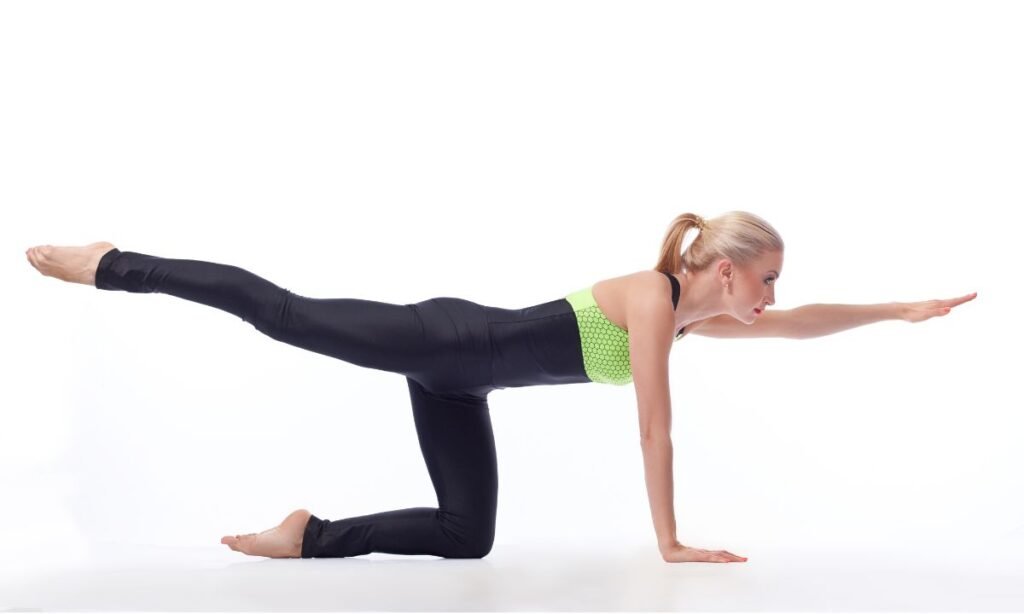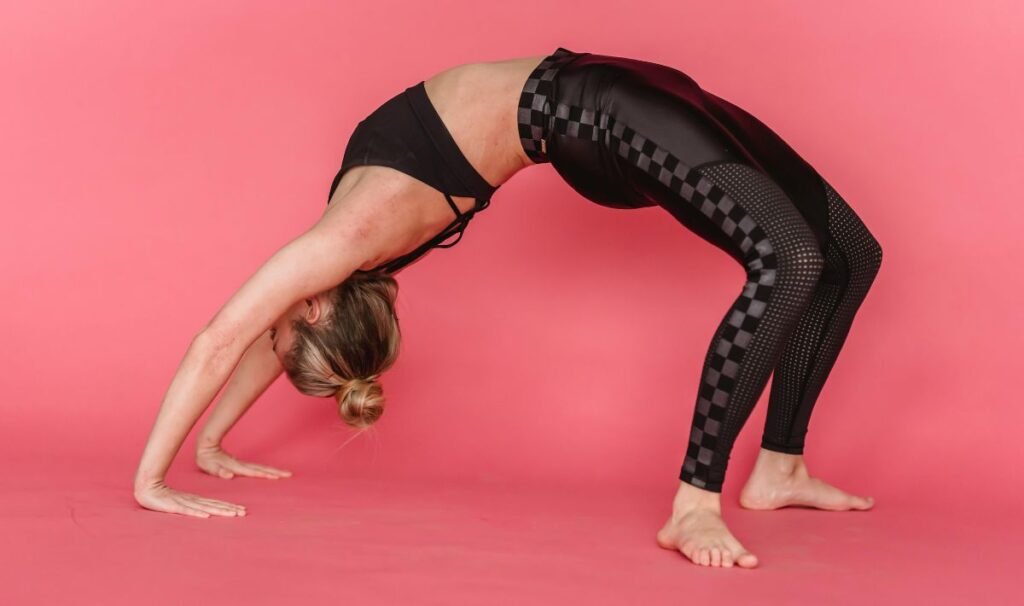Balancing Table Pose, also known as Dandayamna Bharmanasana or Spinal Balance Pose, is a foundational yoga position that strengthens the body, improves coordination, and promotes mindfulness. Whether you’re a beginner or a seasoned yogi, incorporating this pose into your practice can provide many benefits for your physical and mental well-being.
In this blog post, we will explore the Balancing Table Pose in depth. You’ll learn how to perform it step by step, learn its incredible benefits, learn common mistakes to avoid, and learn tips to perfect your form. We’ll also delve into why this pose is a favorite among yoga practitioners for building balance, focus, and strength. Let’s dive in!
What is a Balancing Table Pose?
Balancing Table Pose, or Dandayamna Bharmanasana, is a dynamic yoga posture performed on all fours. It’s a transitional pose that engages the core, strengthens the spine, and improves balance. This pose is often used in yoga flows to warm up the body, build stability, and prepare for more advanced poses.
The name “Balancing Table Pose” comes from the table-like position of the body, with one arm and the opposite leg extended, creating a balance challenge. It’s also referred to as Spinal Balance Pose because it encourages alignment and stability in the spine.
How to Perform Balancing Table Pose: Step-by-Step Guide
Here’s how to perform a Balancing Table Pose with proper alignment:
- Begin in Tabletop Position:
- Come to all fours on your yoga mat.
- Align your shoulders directly above your wrists and your hips above your knees.
- Keep your back neutral and your gaze slightly forward.
- Engage Your Core:
- Pull your belly button gently toward your spine.
- This activation will help stabilize your body and protect your lower back.
- Extend Your Right Arm:
- Reach your right arm forward, parallel to the ground.
- Keep your palm facing inward, as if shaking someone’s hand.
- Lift Your Left Leg:
- Extend your left leg straight back, parallel to the ground.
- Flex your foot so your toes point toward the floor.
- Find Your Balance:
- Keep your hips level and your core engaged.
- Maintain a straight line from your extended hand to your heel.
- Hold the Pose:
- Stay here for 3-5 breaths or longer, focusing on stability and alignment.
- Switch Sides:
- Lower your arm and leg back to the Tabletop Position.
- Repeat on the opposite side with your left arm and right leg extended.
Mistakes and How to Avoid Them
While Balancing Table Pose may seem simple, there are common mistakes to watch out for:
- Arching the Back: Keep your spine neutral to avoid unnecessary strain.
- Dropping the Hips: Ensure your hips stay level by engaging your core.
- Tensing the Neck: Keep your gaze forward and avoid straining your neck.
- Rushing the Movement: Take your time to find balance and alignment.
Benefits of Balancing Table Pose
Balancing Table Pose offers a wide range of benefits, making it a valuable addition to any yoga practice. Here are some of its key advantages:
1. Strengthens Core Muscles
Engaging your core during this pose helps strengthen abdominal and lower back muscles, improving overall stability and posture.
2. Enhances Balance and Coordination
Balancing on the one hand and the opposite leg challenges your coordination and proprioception (awareness of body position).
3. Improves Spinal Alignment
The pose encourages a neutral spine, which is essential for maintaining good posture and reducing back pain.
4. Builds Focus and Concentration
Holding the pose requires mindfulness and concentration, helping you stay present in the moment.
5. Prepares for Advanced Poses
Balancing Table Pose lays the groundwork for more challenging balancing and core-strengthening postures.
Tips for Perfecting Balancing Table Pose
If you’re struggling to maintain balance or alignment, these tips can help:
- Use Props: Place a folded blanket under your knees for extra cushioning.
- Focus on a Drishti: Choose a fixed point on the floor to help maintain your balance.
- Engage All Muscles: Activate your glutes, shoulders, and core for better stability.
- Practice Gradually: Start with shorter holds and gradually increase the duration as you build strength.
- Work with a Mirror: Use a mirror to check your alignment and make adjustments as needed.
Variations and Modifications
Balancing Table Pose can be modified or enhanced to suit different skill levels:
- Beginner Modification:
- Keep your toes on the ground instead of lifting your leg for added stability.
- Advanced Variation:
- Add a crunch by bringing your elbow and knee together under your torso before extending again.
- Dynamic Flow:
- The transition between sides is in a slow, controlled manner to create a flowing sequence.
When to Avoid Balancing Table Pose
While this pose is generally safe, there are a few instances where caution is necessary:
- Injuries: Avoid if you have wrist, shoulder, or knee injuries unless under the guidance of a yoga instructor.
- Pregnancy: Consult with a healthcare professional or yoga teacher before practicing if you’re pregnant.
- Balance Issues: Use props or support if you have difficulty maintaining balance.
Incorporating Balancing Table Pose into Your Practice
Balancing Table Pose is versatile and can be included in various yoga routines:
- Warm-Up: Use it to activate your core and stretch your body before moving into more dynamic poses.
- Cool-Down: Incorporate it at the end of your practice to relax and realign your spine.
- Standalone Exercise: Practice it daily to build strength and improve balance over time.
FAQs About Balancing Table Pose
1. Who can practice Balancing Table Pose?
Balancing Table Pose is suitable for individuals of all fitness levels, including beginners. However, those with injuries or specific conditions should consult a yoga instructor or healthcare professional before practicing.
2. How long should I hold the Balancing Table Pose?
Hold the pose for 3-5 breaths on each side. As you build strength and stability, you can gradually increase the duration.
3. Can I practice this pose every day?
Yes, Balancing Table Pose can be practiced daily. It’s a gentle yet effective exercise for building core strength and improving balance.
4. What are some common challenges with this pose?
Common challenges include maintaining balance, keeping the hips level, and avoiding arching the back. Focus on engaging your core and moving mindfully to overcome these issues.
6. How can I modify the pose if I’m a beginner?
Beginners can keep their toes on the ground or practice lifting just the arm or leg separately until they build enough strength and confidence.
7. Is Balancing Table Pose beneficial for back pain?
Yes, this pose can help alleviate back pain by strengthening the core and encouraging proper spinal alignment. However, those with severe back issues should practice under professional guidance.
8. Can children practice this pose?
Absolutely! Balancing Table Pose is simple and safe for children, helping them develop better balance, coordination, and focus.
Final Thoughts
Balancing Table Pose (Dandayamna Bharmanasana) is a deceptively simple yet powerful pose that offers numerous benefits for your body and mind. By practicing this pose regularly and paying attention to proper alignment, you can build strength, improve balance, and enhance your overall yoga practice.
Remember, yoga is a journey. Progress takes time, so be patient with yourself and enjoy the process. The next time you step onto your mat, give Balancing Table Pose a try and feel the difference it can make.
Happy balancing!

Sonu is a passionate yoga teacher with over 6+ years of experience helping individuals find balance, strength, and inner peace through the transformative power of yoga. As the creator of Pure Yoga Vibes, Sonu shares expert insights, inspiring practices, and a wealth of knowledge to support your wellness journey. Dedicated to creating a space for growth and mindfulness, Sonu’s mission is to make yoga accessible and enjoyable for everyone. For inquiries or collaborations, feel free to reach out at contact@pureyogavibes.com.



